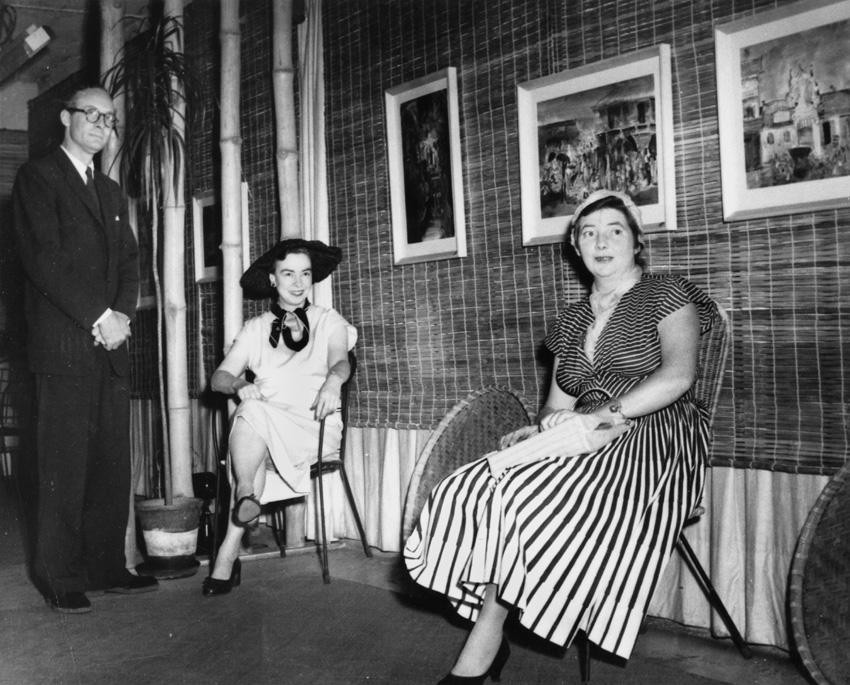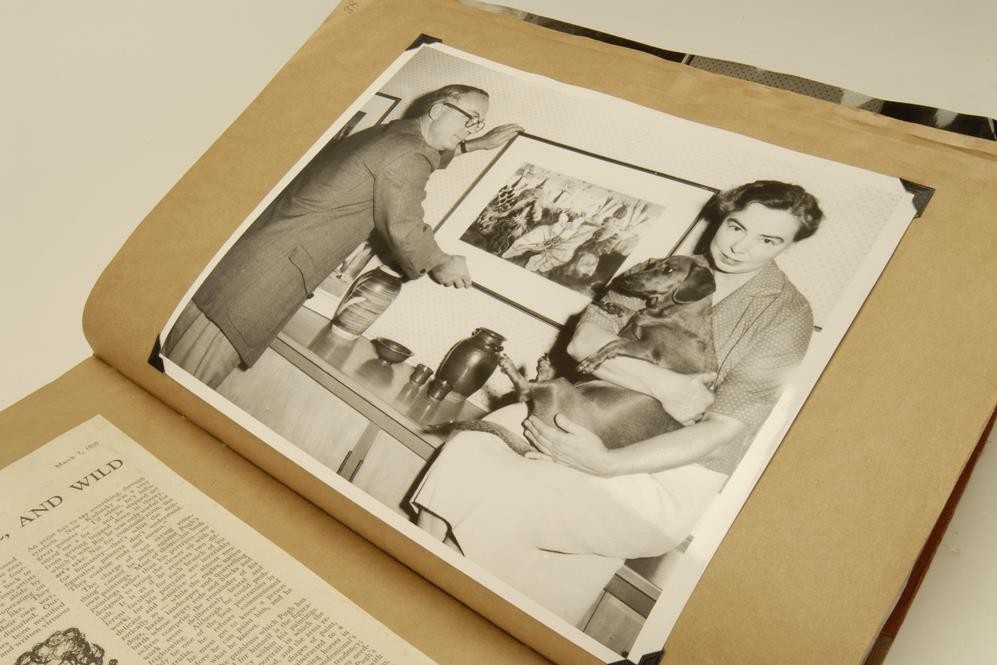- Home
- Johnstone Gallery Archive resources
/
Johnstone Gallery Archive resources
What was the Johnstone Gallery?
The Johnstone Gallery was a commercial art gallery in Brisbane from 1950 to 1972 during a seminal time in the development of an audience for contemporary art in Australia. Operated by Brian and Marjorie Johnstone, it brokered strong sales year after year for Australian artists of the period, including Charles Blackman, Sidney Nolan, Donald Friend, Arthur Boyd, Ray Crooke, Margaret Olley and others. One of Australia’s foremost galleries, it was a leader in its choice of artists, display style and sales methods. It was a focal point of artistic and social life in Brisbane with its Sunday exhibition openings becoming legendary. When it eventually closed in 1972, there was a very real sense that this was the end of an era.
Who were the Johnstones?
Brian Johnstone was born in India in 1920 and spent part of his childhood there before his family came to Australia. He attended St Peter's College in Adelaide and after graduation from the Royal Military College, Duntroon in 1941 was in continuous full-time war service until 1949. His final posting in July 1949, as Aide-de-camp to the Governor of Queensland, Sir John Lavarack brought him to Brisbane and gave him an introduction to the Brisbane establishment.
Born in Brisbane in 1911, Marjorie Johnstone (nee Mant) was a popular and respected actress by the time she met Brian Johnstone in 1949. By all accounts, Marjorie was an unforgettable character and remarkable woman, whose friends and acquaintances remember her zest for living, style and personality. She had a dramatic approach for every occasion, a talent that facilitated her theatrical career and came into its own during the life of the gallery. Brian and Marjorie married in September 1950 and the gallery opened soon after.
During 1958 Brian and Marjorie acquired a dachshund puppy. Named Lindy, she became a much loved member of the family and a constant and sometimes threatening presence in the Gallery, capable of biting visitors without warning. The Johnstones' friends and their pets regularly sent her birthday and Christmas cards, letters and photographs, all faithfully recorded in the Johnstone Gallery Archive Scrapbooks. Sadly missed after her death in 1972 she was described by Marjorie as “Ruler Absolute of the House of Johnstone”
Where was the Johnstone Gallery?
Brian and Marjorie Johnstone's first enterprise, the Marodian Art Gallery, opened in Upper Edward Street in December 1950. The gallery was a joint venture with interior decorator Hugh Hale, and was located at the back of his conservative city shop. An argument over the work of Donald Friend and Arthur Boyd led to the end of the partnership. In February 1952 the Johnstones relaunched the gallery under their own name in an ex-air raid shelter in the basement of the Brisbane Arcade.
The Johnstone Gallery had a distinctively modern but inexpensive style with potted palms at the entrance, calico lined walls, bamboo blinds, cane dividers and sea-grass mats. Showing local artists like Laurence Hope and Margaret Olley along with interstate figures such as Sidney Nolan, Grace Cossington Smith and John Passmore, it also offered decorative arts including ceramics, Persian carpets, pottery, enamels, furniture and glass. The Johnstone Gallery quickly developed momentum, with a loyal group of artists, enthusiastic patrons and a program of style and quality. In 1954 they opened the custom-designed Home Salon at their residence in Cintra Road, Bowen Hills. It was intended to complement the Brisbane Arcade Gallery.
In December 1957 the Brisbane Arcade Gallery closed, victim to both its inadequacy as an exhibition space for large modern paintings and Brian Johnstone’s diagnosis with tuberculosis. Following his recovery in October 1958 The Johnstone Gallery was reopened at their home in Bowen Hills. The gallery was extended from the Home Salon at 6 Cintra Road into the cottage next door at 8 Cintra Road, which Marjorie also owned as part of a family inheritance. Here their innovations in the display of art became evident. People responded to the domestic ambience, the subtropical sculpture gardens and the spectacular and theatrical ways in which the art was presented and launched at Sunday morning exhibition openings.
Exhibition spaces were regularly developed and extended with extra galleries including Gallery F to show the work of emerging artists, a Collectors Gallery, a Storeroom Gallery and an Annexe Gallery designed by architect Vitale Gzell to include a wall to showcase paintings up to 20 feet in length.
The Johnstones were heavily involved in the theatre, providing at very low cost the land on which the Twelfth Night Theatre was situated beside the Gallery and contributing to fundraising for its building.
Friends and colleagues of the Johnstones were shocked when they decided to close the gallery on December 19, 1972. Its legacy as a leader in the development of art, artists, commercial galleries and a wider cultural community in Australia lives on in the treasure of its archives at the State Library of Queensland.


What is the Johnstone Gallery Archive?
All aspects of the gallery and its owners Brian and Marjorie Johnstone are documented in The Johnstone Gallery Archive which was bequeathed by Marjorie to the State Library of Queensland. Including scrapbooks, correspondence and exhibition catalogues it is a major resource for provenance research of Australian artworks and one of the State Library’s most heavily used collections. The archives are a source of information concerning exhibition dates, public relations initiatives, clients, relationships with artists, the gallery's physical development, and contextual information.
Scrapbooks: Throughout the life of the Johnstone Gallery and beyond, Marjorie compiled scrapbooks which record the history of the gallery - invitations to gallery openings, gallery catalogues, newspaper reviews, photographs, sketches and doodles by artists, and letters, both business and personal. Christmas cards from artists, often containing original artworks, and newspaper and magazine articles about the Johnstone’s wide interests lend an idiosyncratic touch to the scrapbooks.
Correspondence: Gallery correspondence spans the early 1950s through to the 1970s. The files, containing inward and outward letters, tell stories about the relationships between the represented artists and Brian Johnstone as gallery director. They detail the day-to-day business of a commercial gallery, the organisation of exhibitions and appraisal of their success. Johnstone’s correspondence with galleries in other states is open and friendly, and often includes frank advice and the benefit of his considerable experience. He also corresponded personally with clients and artists on all matters, ranging from possible purchases to art world personalities and gossip, always with his distinctive flair and wit.
Exhibition catalogues: The Johnstone Gallery produced catalogues to accompany most of its exhibitions and, as the years progressed, the catalogues reflected a gallery that was growing in prosperity as they developed into lavish productions with colour plates and short essays about the artist. The catalogues usually included a complete list of works, making them an invaluable resource. Exhibition catalogues are stuck in the Scrapbooks, but many are also available in a separate collection.
Photographs: Many photographs can be found in The Johnstone Gallery Archive – in the scrapbooks, photograph albums and correspondence files. These record gallery exhibitions and openings, but also personal occasions, parties and social events that were so much a part of the spirit of the Johnstone Gallery.
Another invaluable, high quality photographic record of the gallery, its exhibitions and décor is the Arthur Davenport Photographic Collection. Arthur Davenport attended exhibitions at The Johnstone Gallery on a regular basis from 1964, photographing exhibition installations and individual works. The slides he produced were used for sales, documentation and promotional purposes. The collection was donated to the State Library of Queensland by Arthur’s wife Len following the Library’s acquisition of The Johnstone Gallery Archive.
Which artists showed with the Johnstone Gallery?
The Johnstone Gallery represented most of the leading Australian artists of the period in which it operated, often having first choice of their works for exhibition. They included Douglas Annand, Charles Blackman, Arthur Boyd, David and Hermia Boyd, Guy Boyd, Ray Crooke, Lawrence Daws, Robert Dickerson, Russell Drysdale, Donald Friend, Laurence Hope, Max Hurley, Kenneth Jack, Keith Looby, Jon Molvig, Sidney Nolan, Kevin O’Connor, Margaret Olley, Clifton Pugh, Lloyd Rees and Len and Kath Shillam.
“A Time Remembered”, the Johnstone Gallery’s second last exhibition, was Brian and Marjorie Johnstone’s personal memorial to the artists who had defined the gallery. It included Charles Blackman, Arthur Boyd, Ray Crooke, Robert Dickerson, Russell Drysdale, Sidney Nolan and Lloyd Rees. These were the biggest names and the source of strong sales throughout the gallery’s 22 year history.
The honour of the final exhibition in December 1972, however, went to the artists who had more shows with the Johnstone Gallery than any others: sculptors Leonard and Kathleen Shillam.
View The Johnstone Gallery Archive Showcase to see images from the Arthur Davenport Photographic Collection, donated to the James Hardie Library of Australian Fine Art by Len Davenport following the State Library of Queensland acquisition of The Johnstone Gallery Archive.
Johnstone Gallery exhibition list
The exhibitions at the Johnstone Gallery have been listed chronologically. The list serves as a comprehensive index to exhibitions at the gallery and provide the exhibition title, date and all artists represented. In addition references to related material in the Johnstone Gallery Archive have been provided. The Gallery Scrapbooks will often include exhibition reviews from newspapers in the pages preceding or following a copy of the catalogue of the exhibition.
PDF · 158 KB
Marodian Gallery exhibition list
The exhibitions at the Marodian Gallery have been listed chronologically. The list serves as a comprehensive index to exhibitions at the gallery and provides the exhibition title, date and all artists represented. In addition references to related material in the Johnstone Gallery Archive have been provided. The Gallery Scrapbooks will often include exhibition reviews from newspapers in the pages preceding or following a copy of the catalogue of the exhibition.
PDF · 21 KB